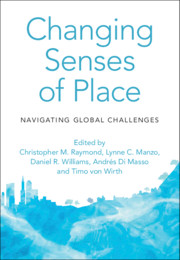Book contents
- Changing Senses of Place
- Changing Senses of Place
- Copyright page
- Dedication
- Contents
- Contributors
- Foreword
- Preface
- Acknowledgements
- Introduction
- Part I Climate Change and Ecological Regime Shifts
- Part II Migration, Mobility and Belonging
- Part III Renewable Energy Transitions
- Part IV Nationalism and Competing Territorial Claims
- Part V Urban Change
- Part VI Technological and Legal Transformations
- Part VII Design and Planning Strategies for Changing Senses of Place
- Part VIII Conclusion
- Index
- References
Introduction
Senses of Place in the Face of Global Challenges
Published online by Cambridge University Press: 15 July 2021
- Changing Senses of Place
- Changing Senses of Place
- Copyright page
- Dedication
- Contents
- Contributors
- Foreword
- Preface
- Acknowledgements
- Introduction
- Part I Climate Change and Ecological Regime Shifts
- Part II Migration, Mobility and Belonging
- Part III Renewable Energy Transitions
- Part IV Nationalism and Competing Territorial Claims
- Part V Urban Change
- Part VI Technological and Legal Transformations
- Part VII Design and Planning Strategies for Changing Senses of Place
- Part VIII Conclusion
- Index
- References
Summary
It is now well established that humans are the most powerful influence on the environment. The scale, pace and intensity of human activity is fundamentally altering earth’s climate system (IPCC, 2014) and driving global biodiversity and ecosystem decline (IPBES, 2019). Simultaneously, new forms and patterns of mobility are emerging and accelerating in a world driven by globalised market forces, new technologies, media transformations and related cultural trends of late modernity (Stokols, 2018; Boccagni, 2017; Cresswell, 1996). Indeed, during the final stages of preparing this volume we are experiencing a global pandemic of COVID-19 that is reshaping society – from the way we travel to how we relate to one another (see the Preface). While many of the global challenges addressed in this volume are not new, they are accelerating to such a degree that they are challenging our sense of ‘ontological security’ in the world, a concept that has been useful in international relations research, and most recently climate change research, to articulate relationships between identity and security (Farbotko, 2019; Kinnvall, 2004). Our expectations for the stability and continuity of our habitats and lifestyles are increasingly being challenged.
- Type
- Chapter
- Information
- Changing Senses of PlaceNavigating Global Challenges, pp. 1 - 18Publisher: Cambridge University PressPrint publication year: 2021
References
- 4
- Cited by



